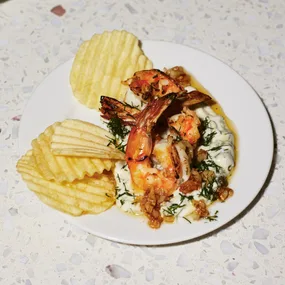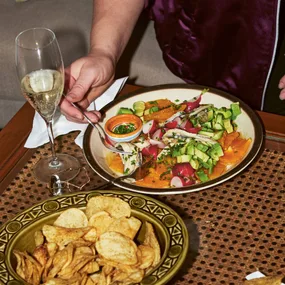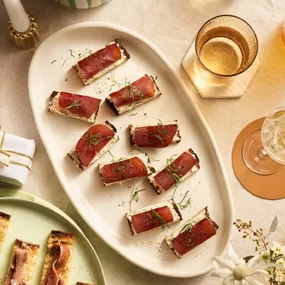You could track down a pre-made mole paste, dilute it with chicken stock and pour it over cooked chicken or turkey. You could also spend hours producing an “authentic” mole from scratch. Or you could make a credible, simplified mole to serve with cooked chicken, turkey or pork.
Legend has it that angels had a hand in the creation of one of Mexico’s most celebrated dishes, writes Colman Andrews. It’s not fast, but mole poblano is food worthy of the gods.
On the wall behind the pastry counter at the 102-year-old Café de Tacuba in Mexico City is an oil painting depicting a gaggle of 17th-century Carmelite nuns, in white robes and black wimples, cooking in the kitchen of the convent of Santa Rosa in the city of Puebla de los Ángeles. The dish they are said to be inventing is one of the most famous and distinctive in Mexican cuisine: mole poblano.
Mole (pronounced in two syllables, mo-lay) is actually both a dish, usually made with turkey or chicken, and the sauce that defines the dish – a mixture of about 20 or 30 spices, chillies, nuts and seeds, and other ingredients, traditionally crushed together with a metate, a Mexican grinding-stone made from volcanic rock. There are many variations on mole (the state of Oaxaca, in southern Mexico, alone claims seven varieties), but the one often considered to be the original – mole poblano – includes an ingredient that seems at first so unlikely, and yet so bewitching, that it has become virtually synonymous with mole: chocolate.
Of course, we’re not talking about Aero bars here. The chocolate typically used for mole poblano was originally not even really chocolate, but simply roasted cacao beans; today, it is more likely to be a tablet or two of drinking chocolate, the kind that’s melted into a hot breakfast drink. And chocolate is only a minor part of the recipe. In addition to several varieties of dried chillies, the recipe can typically include crushed almonds, peanuts, pine nuts, sesame and pumpkin seeds, cinnamon and cloves, dried bread and tortillas, garlic, tomatoes and tomatillos, and chicken or turkey stock. The result is undeniably exotic, but also somehow comforting in the way it blends sensations of salt, sweetness, sourness, faint bitterness and faint heat.
It’s no wonder that an estimated 99 per cent of Mexicans claim to have eaten mole, and that it’s considered essential to almost any celebration. (The phrase “Ir a un mole” – to go to a mole – means to attend a wedding.)
The irony is that mole poblano isn’t purely Mexican at all. The creation myth for the preparation – first recounted in print only in 1926, but never mind – involves those Carmelite nuns in Puebla. One day, back in the latter 1600s, it seems, they received word that the local archbishop planned to visit their convent. They had no special food to offer this esteemed guest, so prayed for guidance until an angel inspired the good sisters – of whom some sources single out Sor Andrea de la Asunción – to mix together everything they had in their larder, making a sauce thick and flavourful enough to disguise the tired flesh of a guajolote, or wild turkey, someone had brought them.
The archbishop was extremely pleased with the results, and the fame of the convent, and of mole poblano, spread – poblano because that’s the adjectival form of “Puebla”. (It must be pointed out, however, that it is also the adjectival form of the noun pueblo, meaning a village; some food historians maintain that mole poblano is simply a mole made in a small town.)
The word mole, it is commonly accepted, derives from the indigenous Náhuatl (Aztec) word mlli, meaning sauce. On the other hand – as I pointed out in a paper that I presented in the Canary Islands in 1992 at a conference on the post-1492 food exchange between Spain and the Americas – the Spanish word for the verb “to crush” is moler, and those Carmelite nuns were mostly, if not entirely, Spanish. And, if the good sisters had a cookbook in their kitchen, it was very likely the most popular and influential Spanish culinary manual of the era, Libre del Coch, compiled by Ruperto de Nola, the Catalan chef to the king of Naples. In it, de Nola describes several variations on mixtures of ground nuts and spices, of the kind later known in Catalan cookery as the picada. One of the characteristic ingredients of the picada for hundreds of years has been… chocolate.
Admittedly, chocolate came to Spain from the New World, and the pre-Columbian population of Mexico almost certainly ground seeds and spices together (they had the tools, the metate and the mortar and pestle called the molcajete). But some of the common ingredients in even the oldest extant recipes for mole include foods that travelled in the opposite direction, from Europe or Africa – among them almonds, sesame seeds, cinnamon, cloves and bread. And the use of bread and nuts crushed into a paste to thicken and flavour food was a Mediterranean technique dating at least to the glory days of the Roman Empire.
It’s also worth noting that chocolate was not used as a food in pre-Hispanic Mexico, only as a beverage. Is it possible that the Catalans started pounding chocolate into their picadas before Mexicans (or the Spanish in Mexico) started adding it to their moles, having borrowed the Catalan idea? We don’t know, probably never will. I would propose, however, that mole poblano was almost certainly a portmanteau creation, a true Old World-New World hybrid – an early example of (pardon the expression) fusion cuisine.
There are now variations on mole all over Mexico. The state of Puebla still proudly claims to have produced the first examples, and hosts a mole festival, with proceeds going to the convent of Santa Rosa and two other local convents. Another municipality with a mole festival is the mountain town of San Pedro Actópan, just south of Mexico City. It has been the country’s mole capital since the mid-20th century, producing about 30,000 tons of pre-made mole pastes and powders annually, which accounts for more than half of all the mole products sold in Mexico. It’s said that at least 90 per cent of the local workforce is involved in the mole trade.
Querétaro, a city-state north-west of Mexico City, is also known for its moles, including a mole verde (green mole), also called pipián, heavy on pumpkin seeds and coloured with tomatillos, parsley, coriander and epazote (a medicinal-tasting herb called goosefoot in the American south-west).
Pipián may have been invented, though, in and around the city connoisseurs consider to be the real capital of mole today, Oaxaca (pronounced wah-hah-ka), south-east of Puebla. Here, mole is almost a cult object.
At Central de Abasto and other markets, sun-wizened women sit on straw mats selling plastic-wrapped blocks of dense mole paste, especially the variety called mole negro (black mole), whose recipe includes prunes, plantains, raisins and a peppery, anise-like herb called yerba santa.
Other Oaxacan moles include mole colorado (red mole), in which tomatoes play a key role; mole coloradito (“little red” mole), made spicier than most versions with chipotle chillies (brick-red smoked jalapeños); mole amarillo (yellow mole), thickened with masa harina (tortilla flour, made from dried field corn treated with slaked lime or wood ash); mole chichilo (from a Náhuatl word for red), flavoured with avocado leaves; and manchamanteles (“tablecloth stainer”), more a stew than a conventional mole, made with various kinds of meat and vegetables in a sauce that sometimes includes puréed pineapple.
Making a mole from scratch can be a tedious, time-consuming project. For that reason, it’s often shared, with a group of friends or family members gathered in the kitchen performing different aspects of the task. Also for that reason, many Mexican cooks buy pre-made mole powders or (better) pastes, even sometimes in jars from the supermarket, perhaps customising their moles with a few added ingredients.
The best of the pastes are first-rate, producing excellent results. It is a measure of how aromatic these pastes can be that in 2010 packages of mole paste set off bomb-detection alarms at Mexico City’s international airport. Since then, officials have asked mole-toting passengers to declare their goods before passing through security.
There’s nothing wrong with tacos, enchiladas and other familiar Mexican fare, but mole poblano – whatever its origins may be – is on another level, a vivid and delicious example of what real Mexican cooking can be: complex, subtle and immensely satisfying.
Ingredients
Method
Main
Note Dried chillies, Mexican chocolate and Mexican oregano are available from Fiji Market in Sydney, fireworksfoods.com.au, chilemojo.com.au, montereyfoods.com.au and delicatessens.
Notes










